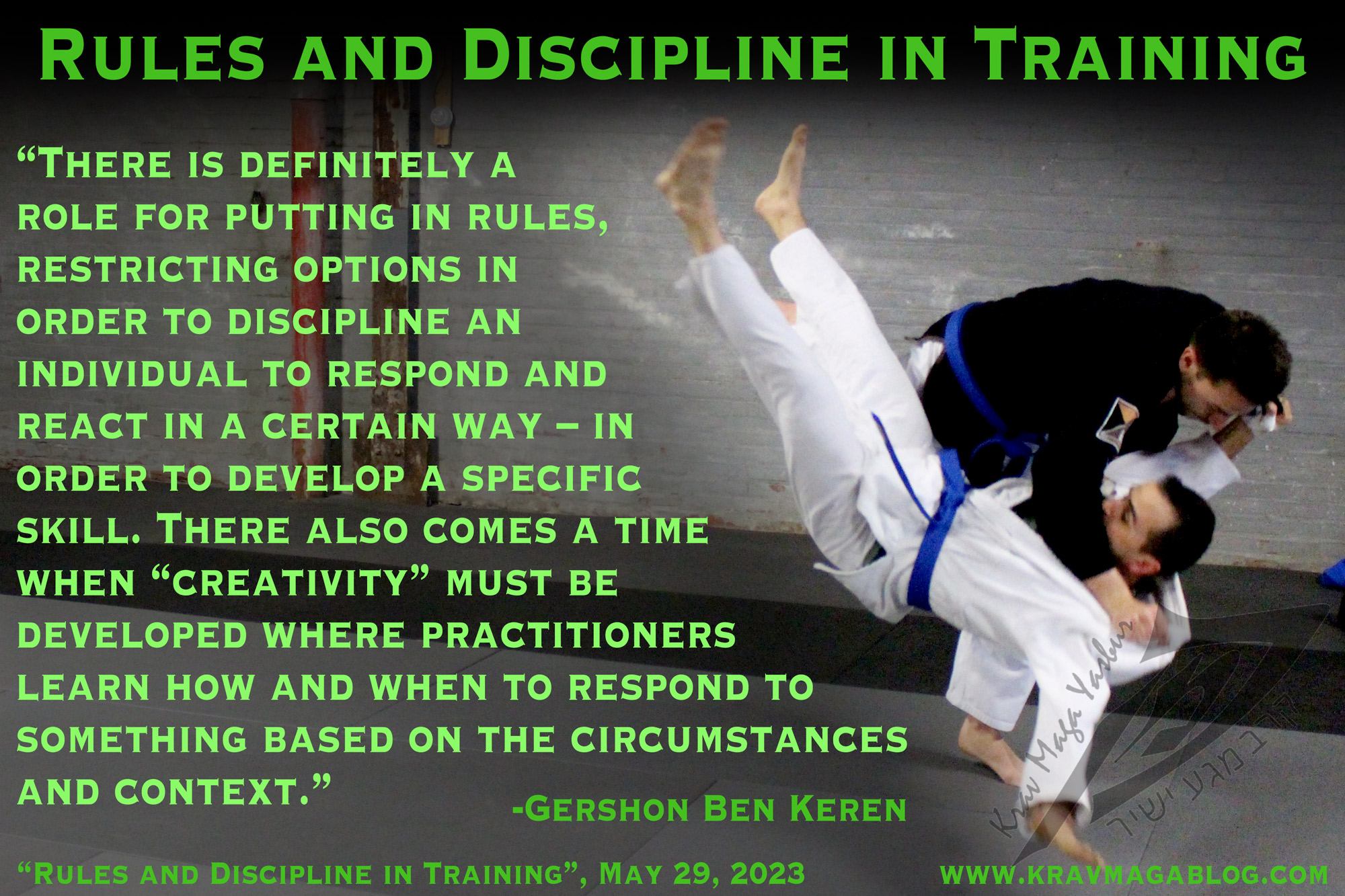When you teach a reality-based self-defense system such as Krav Maga, there is often an expectation, and to a lesser extent a “demand”, that the way you train is chaotic and unstructured, in order for you to replicate, the messy and confused nature of real-life violence e.g., sparring should involve groin attacks, unfettered aggression, and wild strikes etc., because these are some of the components of actual violence, and to leave them out would be disingenuous. I have seen video clips of Krav Maga “sparring” that basically resemble (with protective headgear), UK military “milling”. Though I’m not sure milling is taught/used anymore, because even the UK army – at some point – must concede, or have conceded, to the danger and evidence of concussions. The basic/simple premise behind milling was to have two combatants, wearing boxing gloves, swing at each other, in an uncontrolled fashion, without any consideration made for/to defense, in order to train aggression, and a never give up attitude etc. I’m not going to get into a debate/discussion as to whether such methods of training are beneficial, or whether they are conducted by instructors who reflect upon a time, when men were “real” men etc. My point being that the lack of rules in milling didn’t actually develop any skills or improve an individual’s technical abilities. To develop skills, you need rules that discipline and confine you, i.e., that prevent and restrict you from doing anything and everything that you might want to do.
There is a reason that Judokas and wrestlers generally have better grappling skills than boxers and Tae Kwon Do practitioners, and that is down to rules i.e., boxing and Tae-Kwon-Do don’t allow grappling, and Judo and Wrestling don’t involve striking (punching and kicking). The rules allow for the development of specific skills, which is the purpose of the particular martial arts e.g., those who practice Tae-Kwon-Do are not looking to be able to fight on the ground, just as those who practice BJJ, are not looking to become great at kicking and punching. The problem comes when practitioners of both arts, don’t acknowledge this, and argue that if you know how to punch and kick when standing, you don’t need to know how to fight/survive on the ground, or if you can always drag someone to the ground, you don’t need to know how to punch and kick etc. Both arguments are fine, if you restrict context, and only ever use your art/system in the context that it was designed e.g., Tae-Kwon-Do doesn’t allow grappling and BJJ doesn’t allow striking etc. However, when you argue that what you have learnt in one context extends to all, there is a problem.
I used to take private yoga classes. I had very specific goals. My flexibility and range of motion have always been poor. There are many reasons for this, including that I have always lifted “heavy” weights and being “too flexible” compromises this. I found a great YOGA instructor however they were of the opinion that if you did yoga, you didn’t need to run, lift weights etc. To her, yoga was the best way to develop both aerobic and anaerobic fitness. Obviously, if you want to improve your aerobic capacity, or your ability to lift more than your body weight, yoga isn’t the most efficient or effective way to do this; great for improving other things such as flexibility, strength at various ranges of motion etc., however exercise, like developing various fighting skills and abilities requires specific types of training e.g., if you want to get good at punching, start training with rules that restrict grappling and kicking; if you want to get good at ground-fighting, then train with rules that promote that type of fighting etc. This doesn’t mean that you are “selling out” as a reality-based self-defense instructor/practitioner. This means that as Krav Maga practitioners we can acknowledge the value of Muay Thai, Boxing, Wrestling and other martial arts, and don’t have to dismiss, undermine and/or devalue the benefits of training in these ways. In fact, we can start looking at how to develop other skills in a similar linear fashion, such as focusing on knife attacks, in a “restrictive” manner. However, from a reality perspective, we will at some point need to “open” these training methods up.
This has always been the Krav Maga method. Starting out with “closed” drills where there is a determined outcome e.g., someone throws a Jab, which is then blocked, and then “opening” the drill up so that the initial strike/punch may be Jab, or a “Cross”, and/or it could be a “Jab” followed by a “Cross” etc. There is definitely a role for putting in rules, restricting options in order to discipline an individual to respond and react in a certain way – in order to develop a specific skill. There also comes a time when “creativity” must be developed where practitioners learn how and when to respond to something based on the circumstances and context.
When a Krav Maga practitioner/instructor responds to other martial arts, and/or forms of training that don’t fully reflect reality, and therefore sees them as obsolete and invalid, there is a major misunderstanding as to what are productive and beneficial training methods. There is a time to train striking as striking, a time to train wrestling as grappling etc., and when this is done by leaving out other dimensions of a real-life fight, it doesn’t invalidate them.
Share:

Gershon Ben Keren
2.8K FollowersGershon Ben Keren, is a criminologist, security consultant and Krav Maga Instructor (5th Degree Black Belt) who completed his instructor training in Israel. He has written three books on Krav Maga and was a 2010 inductee into the Museum of Israeli Martial Arts.
Click here to learn more.

